When you visit the city of Venice, you’ll notice everywhere you look masks hanging in shop windows. These Venetian masks have become almost synonymous with Venice, a de facto icon of the city. Walking into some of these shops, it seems like a forest of masks. They are hanging from the ceiling and covering almost every single inch of wall space around you. But what might surprise you is that each different design has a story to tell. Behind each mask, is a piece of Venetian history or references to old theatrical tropes.
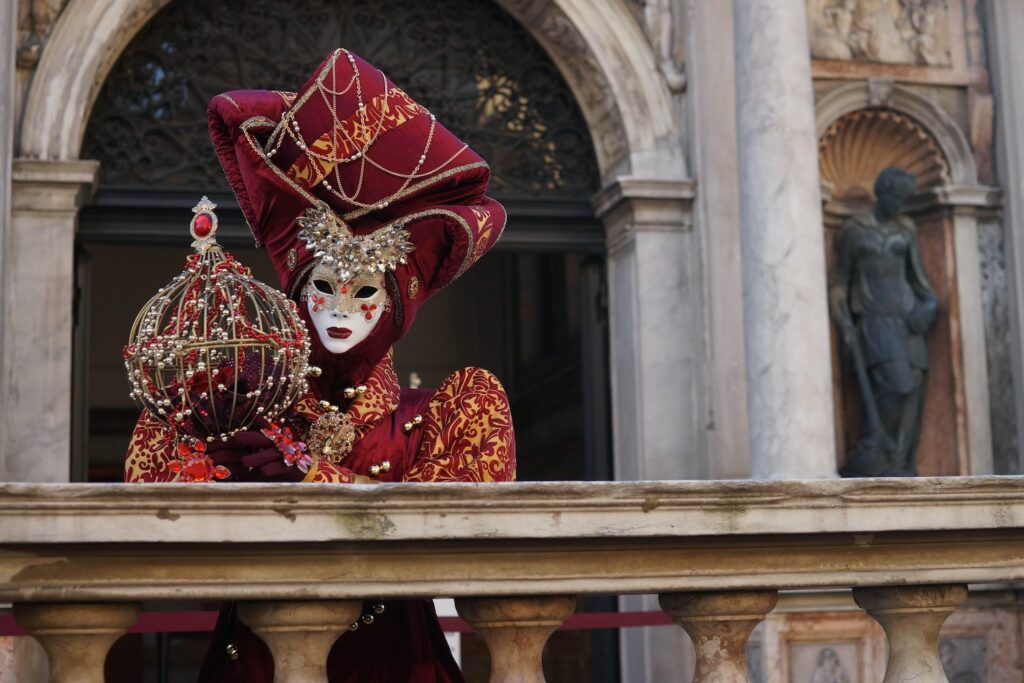
Coming home from Venice, the best souvenir to bring with you or give to another is definitely a Venetian mask. But it’s so important to know how to find and spot an authentic mask as well as where to buy them. Hopefully, this little guide helps you in your quest to learn more about this amazing tradition and finding your perfect mask.
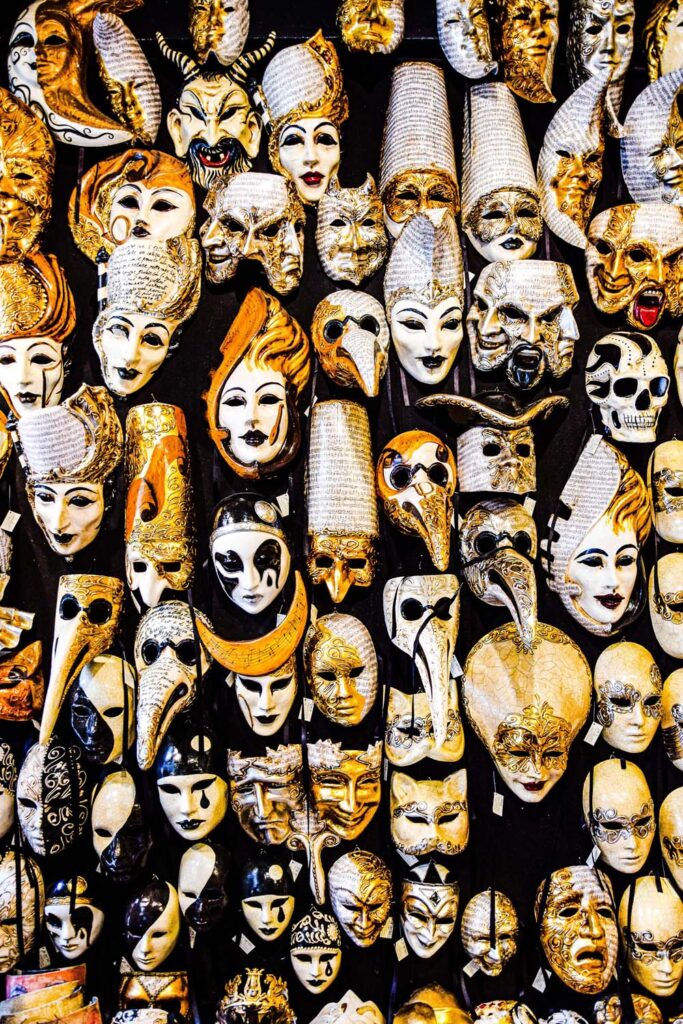
History of Masks in Venice
Today, Venetian masks are mainly associated with Carnevale di Venezia or the Carnival of Venice. But their origin in the city pre-dates Carnival by a few hundred years. No one seems to know exactly when Venetians started wearing masks to conceal their identity. But there have been accounts of this as early as the 11th century. Venice had a prime location in Europe, adjacent to major centres of trade with both the middle east and Europe. This meant that the Republic lead the way in economic development based on trading valuable goods. Most of its citizens were making a fairly good living, and with flush income, came the desire to spend! But more often than not, the way they wanted to indulge themselves was in a rather less than “honourable” manner. At least that was how it was viewed at the time.
Although it was illegal to gamble, casinos began popping up all over the place, even in convents! Sexual promiscuity and prostitution were rampant. Despite homosexuality being condemned by the church, Venetians embraced it! The city was relatively small, and people lived basically one on top of the other. There was no chance for the secretary in a city with eyes everywhere you looked. So people began to wear masks to conceal their identity. Nuns and priests were able to don a mask and dress as lavishly as they wanted, unrestrained from the restrictions of the pious church. Masks allowed you to remain anonymous and live your life to your heart’s desire.
Masks as Disguise
But wearing masks was not solely as a means for sinful activity. With a mask on, and no way of identifying a rich person from a poor person, a group of wearers would all be seen as equal. A servant could speak out against a nobleman without being identified and therefore could express opinions without retribution. The earliest masks worn by the public were not to the opulent as the ones we know of today. Most often, they were plain unadorned faces painted either black of white.
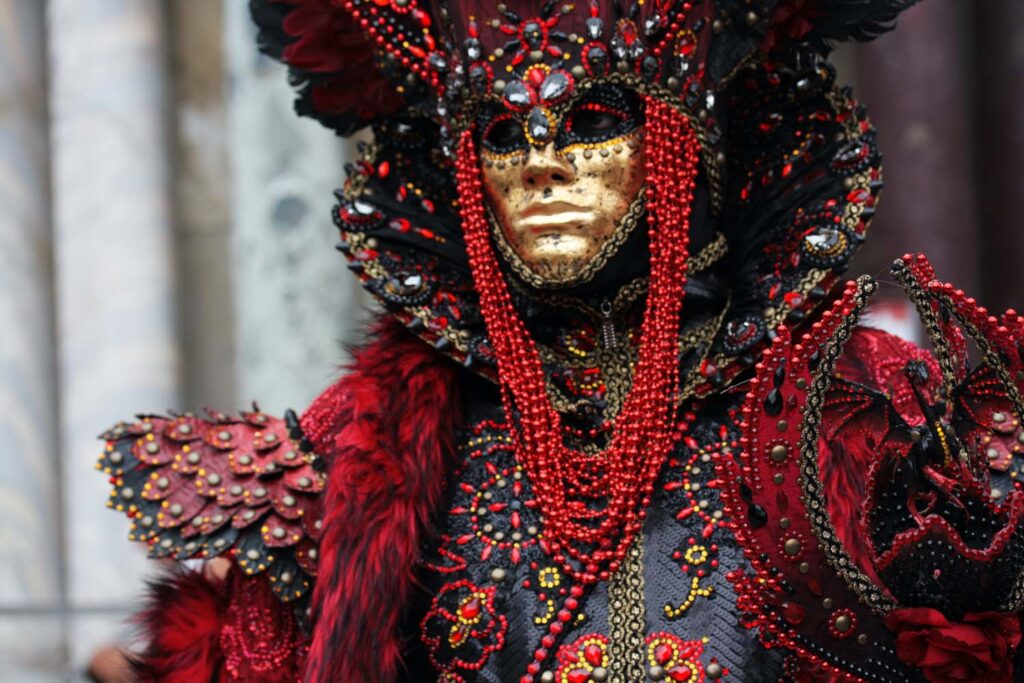
For many years, despite the church abhorring the sinful atmosphere in Venice, they turned a blind eye. They did so in exchange for the wealth that the city brought into Italian coffers. But things began to get a little out of control in the 13th century. Historical documents recorded this anarchic behaviour. One report detailed how people in masks were throwing eggshells filled with perfume off balconies onto the people below. Another document reported how masked men were gambling, visiting convents and using vulgar language. All pretty tame with today’s perspective but back then it was the talk of the town!
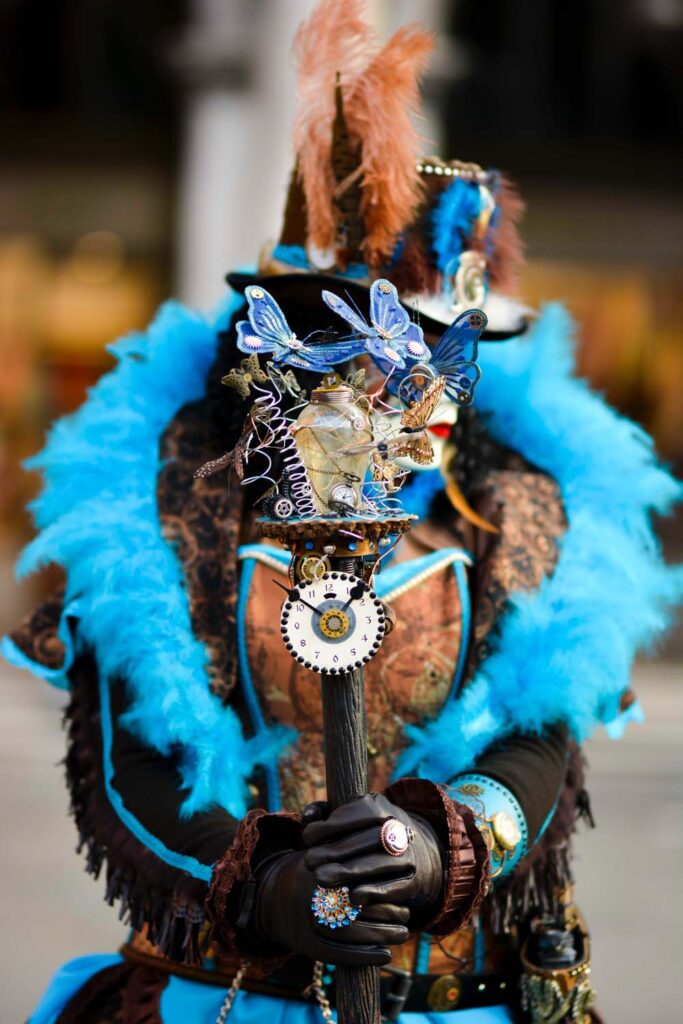
Rome’s New Mandate
Finally, Rome was forced to place a limit on the times during the year where mask-wearing would be allowed. They hoped this would curb the city’s lawless behaviour. Rome mandated that starting on December 26th, citizens would be allowed to wear masks until Shrove Tuesday. This was in order to protect the various holy days from being marred by the city’s lawlessness. Venetians took to ensuring that their masks were as fanciful and elaborate as possible in anticipation of their debut on December 26th! If you could only wear masks for a few months of the year, they wanted them to at least make a statement!
Carnevale di Venezia
Carnevale di Venezia or the Venice Carnival, was established in 1168. It began as a celebration in honour of the Republics’ victory against Padua and Ferrara. The victory celebration started right before the beginning of Lent. This date was very important. During Lent, a myriad of rich food (meat, sugar, fats) were off limit for 40 days! Before the start of lent many large households needed to find a way to use up all those banned ingredients. And what better way, than to throw a huge party! Since Carnival occurred during the months in which mask-wearing was allowed, masks became almost required for attending any decadent Carnevale celebration. Masks were worn during Carnival to help conceal the identities of both the lower and upper classes. This way everyone could dance and celebrate together without the social hierarchy getting in the way.
Carnival was abolished with the falls of the Venetian Republic, at the end of the 18th century. And mask-wearing banned with it! It wasn’t until the 1970s when Carnival was brought back to life. Surprisingly enough, its rebirth was at the hands of a bunch of university students who embraced the hippie lifestyle. Hippies were counterculture advocates. They felt that since these masks had been banned, wearing them was almost an act of rebellion. But soon, Venetians who weren’t a part of the hippie movement began also embrace wearing these masks once more. It was a reemergence of Venetian history. Additionally, artists and shops saw it as big business for locals and tourists alike. Before you knew it, mask shops were popping up on every corner!

How Masks are Made
Traditional Venetian masks are made today in exactly the same manner that they were made in the past. A large piece of clay is carved into the desired face or mask shape. Each detail hand-sculpted by the artist. This is then used to create a chalk mould. The mould is then covered in papier-mache. Once dried it is removed from the mould and the excess edges of the papier-mache are cut off. Gesso paint is used for the base and then more paints are applied to give it colouring and shading. Gold leaf is traditionally added along with feathers, fur, ribbons, gems and glitter. Glue is sometimes used to create raised patterns on the mask and then covered in gold leaf. Some of the most intricate designs can take 2-3 weeks for one individual artist to finish.
Mask Styles | Historical
There are three main categories of mask designs you’ll find in shops today in Venice. The first are historical reproductions of traditional masks whose designs originated in Venice.
Bauta
The Bauta mask is one of the oldest styles. This mask was almost always accompanied by a tricorn hat and cape. Even when masks were banned throughout the year, the Bauta was an exception. These masks were required for women to wear if they attended the theatre. The word bauta comes from the German “behüten“, which means to protect. Men had to wear them during certain key governmental votes to protect their political opinions from each other. The mask would cover the entire face but was angled outwards so the wearer could eat, drink and speak easily without having to remove the mask. This made it perfect for parties to remain anonymous while being able to keep the wine flowing.
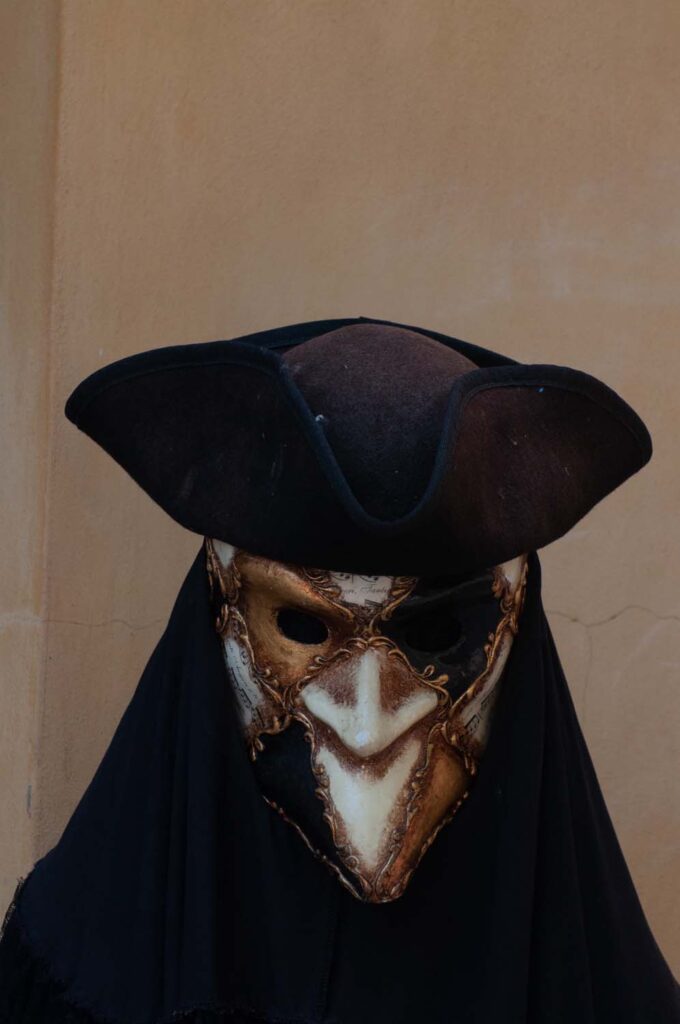
The Plague Doctor
The Medico Della Peste or Plague doctor mask was originally worn by doctors during the plague. It was a functional mask instead of an aesthetic one. The long beak which extends from the covered face was stuffed with herbs and spices which were thought to prevent infection in the 17th century. This technique was developed by French physician Charles de Lorme and as silly as that idea seems now during the plague these masks where thought to be the doctors saving grace.
The mask is white with two round black spectacles painted around the eyes. The spectacles were meant to represent crystals which were thought to protect the wearer’s eyes. Today people continue to wear the Plague Doctor mask as its haunting past evokes such powerful emotions and creepy vibes. There is nothing like seeing that beak silhouetted on the canals to make you feel a shiver up your spine.
Gatto
The Gatto mask is very easy to identify, as it looks like the face of a cat. Gatto, in Italian means cat. Cats were considered to be almost heroes by Venetians after the plague. Cats were actually thought to be responsible for saving the city from complete destruction. And there is a bit of truth to this, as cats would eat the rats which carred the plague and infected the citizens. Thereafter cats were an honoured creature and masks were even made to pay homage to their greatness.
The Jester
The Jester is clown mask that dates all the way back to the middle ages. Jesters were originally considered to be soulful opposites of a king. Instead of being touched by God for greatness, they were touched by madness. But Kings were encouraged to give these people work in their courts are they were nevertheless still touched by God and shouldn’t be rejected. The jesters uniform most frequently consisted of a cap and bells and these elements were incorporated into their masks. Jesters’ roles evolved and they were considered men of great wit and skill. They were acrobatics, juggling, comedians, and even some times magicians. Jester masks are some of the most interesting masks with so many details and I love the noise they make. You always know if a Jester is close by listening for those jingle bells echoing down the canals.
Dama
The Dama mask is one of the heaviest and largest masks you can find. It is full-faced, heavily gilded, with often a sculpture of a large coif added to the top. These coifs were how Venetian women were thought to wear their hair during the Cinquecento period (which was between 1500 to 1599). Women at this time also wore very expensive clothing covered in jewels and needed a mask which would be just as ornate! These are amazing masks for those that want to make a statement.
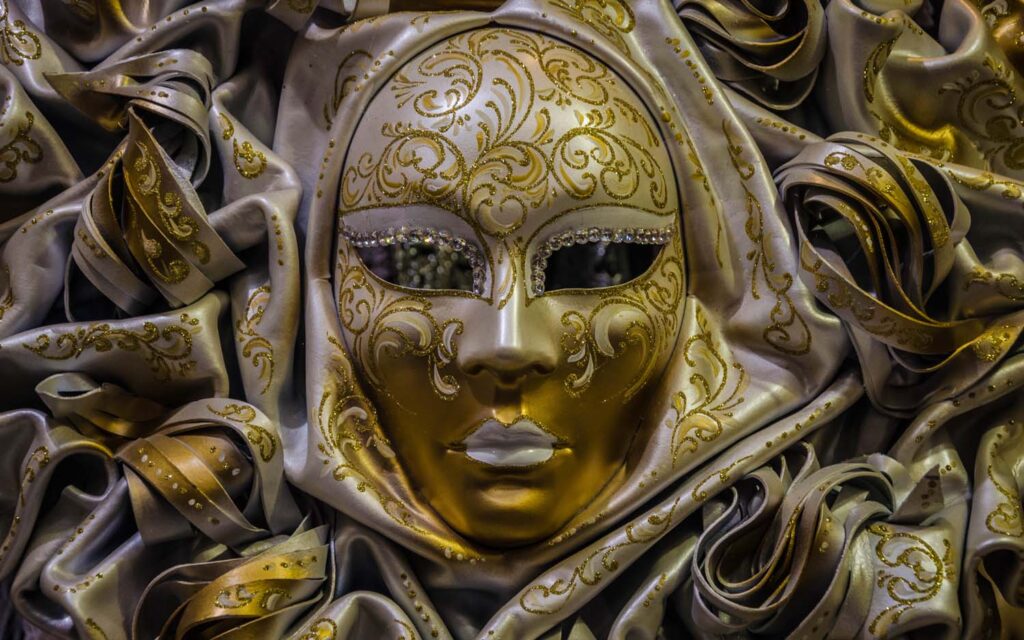
Volto
The Volto mask is also known as the “larva” mask. The word larva in Italians means ghost. In the moonlight, these white painted masks worn with large cloaks and hats would give the appearance of a ghost floating around the canals of Venice. The mask is also known as the “citizen mask” as it was often worn by common people during the holidays. Traditionally these masks were relatively simple, usually painted plain white with some black around the eyes to accentuate that feature. Today they are still generally kept simple but are great for personalizing as people will often add a few details to tie the mask in with their outfit or costume.
Mask Styles | Commedia dell’arte
The second category of Venetian masks is the Commedia dell’arte designs which were inspired by theatrical productions.
Columbina
The Columbina is a delicate half-mask, which was often worn only by women. Traditionally this mask would be tied to the face by a ribbon or held up on a long stick. Commedia dell’arte was an early form of professional theatre, originating in Italy. Actors and actresses in these productions would frequently wear masks to either change their appearance to suit a specific character or were even by men when they were required to play female parts.
Famously there was a popular actress named Columbine who performed in one of these Commedia dell’arte. She thought herself too beautiful to have her entire face covered so the production designed a half mask for her to wear. It is this design, which is named after her, which is today still one of the most popular masks you’ll find in Venice today. These masks are often decorated with gold, silver, crystals and feathers as it is meant to really exemplify that theatrical feeling. The masks highlight the eyes on the face and therefore these masks are often considered to be some of the most alluring.
Scaramouche
The Scaramouche is my FAVOURITE of all the Venetian masks. It was worn in plays when representing a young adventurer! Often thought of a swashbuckling pirate or masked henchman. The Scaramouche mask wearer often dons a typical black Spanish dress which they can use to flit about and hide in the shadow. I love the exaggerated nature of this mask and love the silhouette is creates on the face!

Pierrot
The Pierrot masks is known as the “sad clown”. In plays, he is the dejected lover. Pierrot desire Colombina, yet she always breaks his heart. His masks are traditionally painted with a tear falling from his eyes and are a favourite with romantic souls.
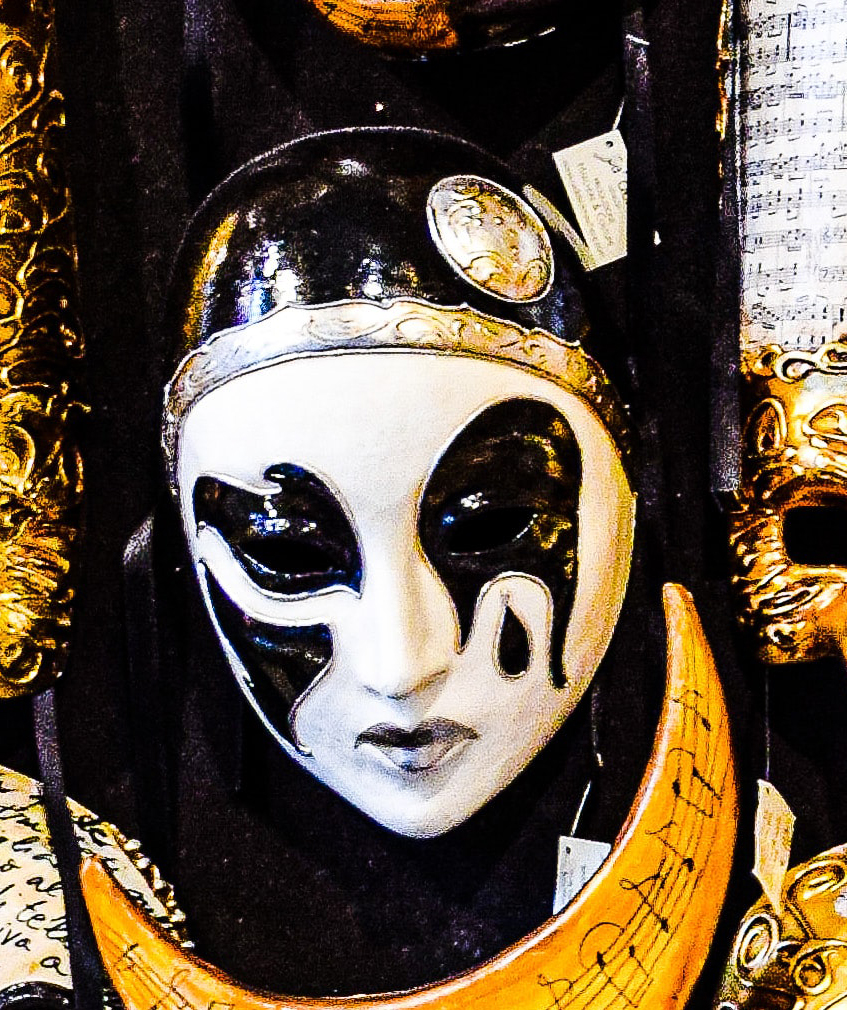
Pantalone
Pantalone was a theatrical representation of an old, miserable man. This character is full of rage, and therefore his mask is always painted red. Black gesso was added to accentuate the folds of aged skin on his face. I think this mask is great for those who want a very expressive mask.
Pulcinella
The Pulcinella is immediately easy to spot by its crooked nose. The face shape was actually the model for the Punch and Judy dolls which were used in puppet theatre in England. The word Pulcinella even means punch. Pulcinella is known for being cruel and violent and his mask is often contorted into a scowl. These masks are great comedic pieces that really will change the way you act and even move in your costume!
Mask Styles | Modern Masks
The third and finaly type of masks are the modern and experimental designs that the new blood of Venetian artisans around bringing to this traditional craft. Some of these masks use references from art forms in their modern creations. Steampunk masks are some of the most popular modern Venetian mask style with gears and cogs featuring heavily in the ornamentation. Whatever these modern artists are creating I love seeing these new styles bringing fresh ideas to the streets of Venice!
How Can you if a Mask is Authentic?
Like many other famous tourist souvenirs, there are always shops all over the city selling fakes. Chinese mass-produced masks are found EVERYWHERE in Venice, especially around St Marks square. And while they might look the part, they are not made in Venice. There is no love put into these masks. And the Venetian artisans who are struggling to keep their craft alive won’t make a dime from those sales.
If you’re a budget traveller, I get it. You might not be able to afford one of the beautiful artisan masks. But just know that those same fake masks in tourist shops can be purchased on Amazon for about $20 USD. So don’t think that you’re really walking away with a piece of Venetian craftsmanship. And usually, for only a few euros more you can find something, perhaps a little simpler, at a real boutique which puts money back into the hands of local Venetians.
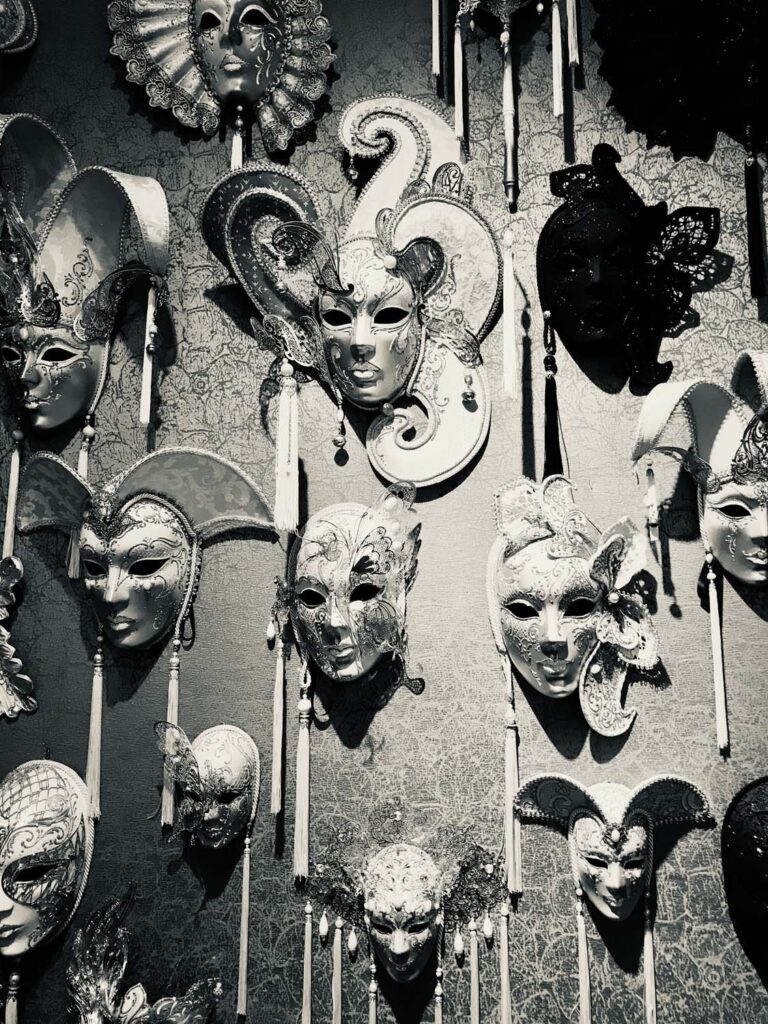
If you want to know whether the mask you’re about to buy was made authentically in Venice or not, go through the following list in your head.
- Check the Price. If the mask seems to cheap, it’s probably because it’s fake and mass produced in China.
- Study the inside. If you see clear signs of papier-mache, layers of paper that can be felt when touched, this is a good sign it’s real. Uniform texture means it’s mass-produced.
- Look for brushstroke. Non-uniform paint marks and brushstrokes mean it’s been hand-painted. Mass-produced masks are spray painted and won’t have brush marks.
- Avoid “made in Venice” stamps. If you see a stamp on the back instead of a sticker, even if it says “made in Venice” this is a good sign its fake. Copycat companies have even gone as far as to falsify these stamps.
- Instead of a stamp, look for a certificate. Hanging on the mask or stuck on the back you’ll always find a sticker or tag which is the certificate of authenticity.
Venetian Mask Shops
So, now you know all about what masks mean and which one you might be most drawn but where can you buy an authentic mask? Check out one of the stores below which I think contains some of the greatest works of art you can find today! To find the best mask shops, stay out of San Marco as anything you find there around St. Mark’s square is almost certainly fake.
Papier Mache Venezia
Papier Mache Venezia can be found in the Castello district and is a great place to buy masks with a slightly unique flavour. This shop sells all the traditional masks, as well as masks painted with images of Venice imprinted onto them. While these masks might be more of a display piece and less of a wearable, I still love that they are offering up something different.
Ca’ Macana
Ca’ Macana has two locations but I think their shop in Dorsoduro a little quieter and you can find more interesting options. This shop is not only a feast for the eyes but since the workshop is inside the store you can watch the artisans making the masks right there! My favourite pieces from their collection are their beautifully crafted animal masks. While these are a departure from traditional masks, they are both so realistic and so fantastical they make such an impact on both the wearer and anyone who lays eyes on them.
La Bottega Dei Mascareri
La Bottega Dei Mascareri is a shop owned and run by two brothers and has been open since 1984. The brothers were really inspired by the medieval court, commedia dell’arte and eighteenth-century Venice. All these historical references are poured into their work and they create some absolutely incredible masks. Despite this high level of craftsmanship, there are masks here that cost as little as €15 which makes them affordable for almost anyone! They also make some really inventive designs, just as the Vincent Van Gogh mask below, which are a real surprise among the traditional masks.
La Gioia
La Gioia is one of the oldest shops in Venice, founded in 1970. While obviously that seems very modern considering the ancient history of Venice, since mask making was only really re-introduced in the 70s this is one of those shops that brought the tradition back to the city! The designs in this shop are fantastically creative. The designers manage to blend traditional shapes with some really lush colours. So many of their masks are then embellished with gold and jewels and have papier-mache swaths of fabrics that surround the mask. These definitely are statement pieces for those of us who aren’t afraid to make a splash!
Il Canovaccio
Il Canovaccio is located close to the tourist hub but tucked away on a side street, therefore, avoid most of the mobs which flow out of the Piazza San Marco. The staff here is incredibly kind and will even be happy to tell you all about the histories behind the different masks and regale you of stories from Carnival! This shop’s specialty is definitely FEATHERS! So many of their masks are adorned in these amazingly rich feathers and I love the elegant embellishments they add to the masks.
Venice Masks by Alberto Sarria
Venice Masks by Alberto Sarria was established in 1986 and quickly became a popular stop for locals and tourists alike to find unique masks for Carnival. One thing which makes their shop a little different is they sell some leather masks. This is obviously a shift from the traditional but the leather masks really have the most interesting look and I love artisans putting their own spin on ancient techniques.
Bluemoon Venice
Bluemoon Venice is an amazing shop that sells some very interesting types of masks such as ones made entirely of metal, with delicate cut-outs. So many of their masks are embellished with Swarovski crystals which makes them really sparkle and shine. But if you find yourself wanting to design your own mask, this shop also sells blank canvases which you can personalize yourself! This is great for kids or for those with a very specific vision in mind! The shop has everything you need from brushes to paints and embellishments to create your own Venetian mask!
Try Before you Buy
Lastly, when you’re ready to make a purchase be sure to ask the staff if it’s ok to try on the masks. This is polite and some of the masks are so delicate they might want to assist you with this. Since these masks are moulded onto a generic face, they will obviously not fit you perfectly. Some masks fit different face shapes better than others so be sure to try on your masks before purchasing if you indeed intend on wearing it. If it’s just for display then no worries there, you can just choose whichever design suits your fancy.
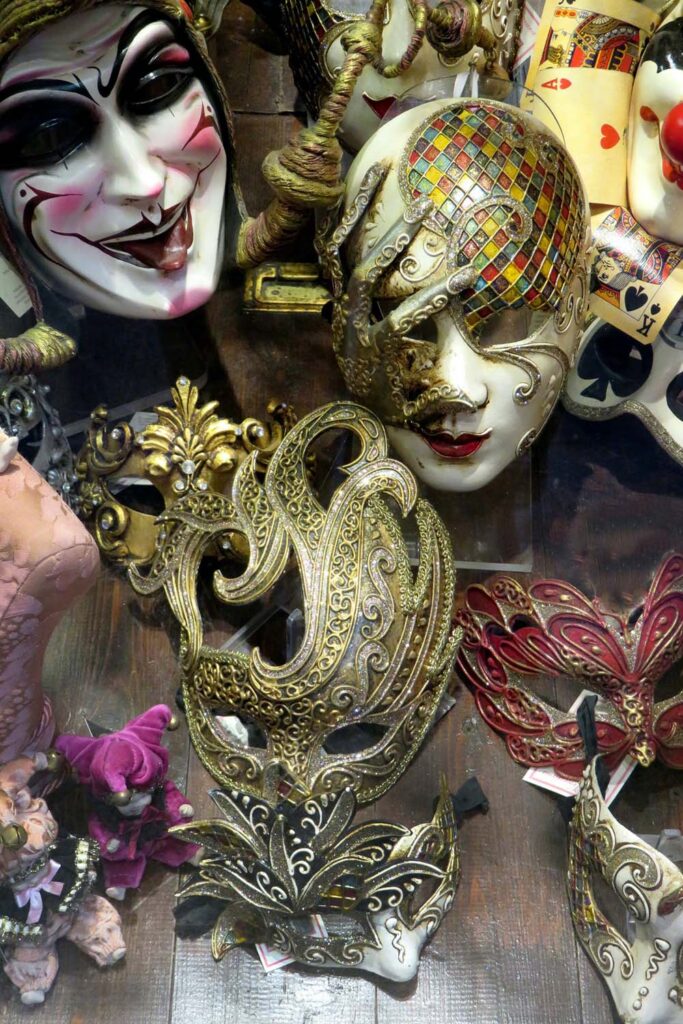
I hope this guide really helps you decide which mask is right for you and helped you understand a bit more about the history of the mask and mask making in Venice. Let me know if the comments which one was your favourite!
Happy Travels Adventurers!
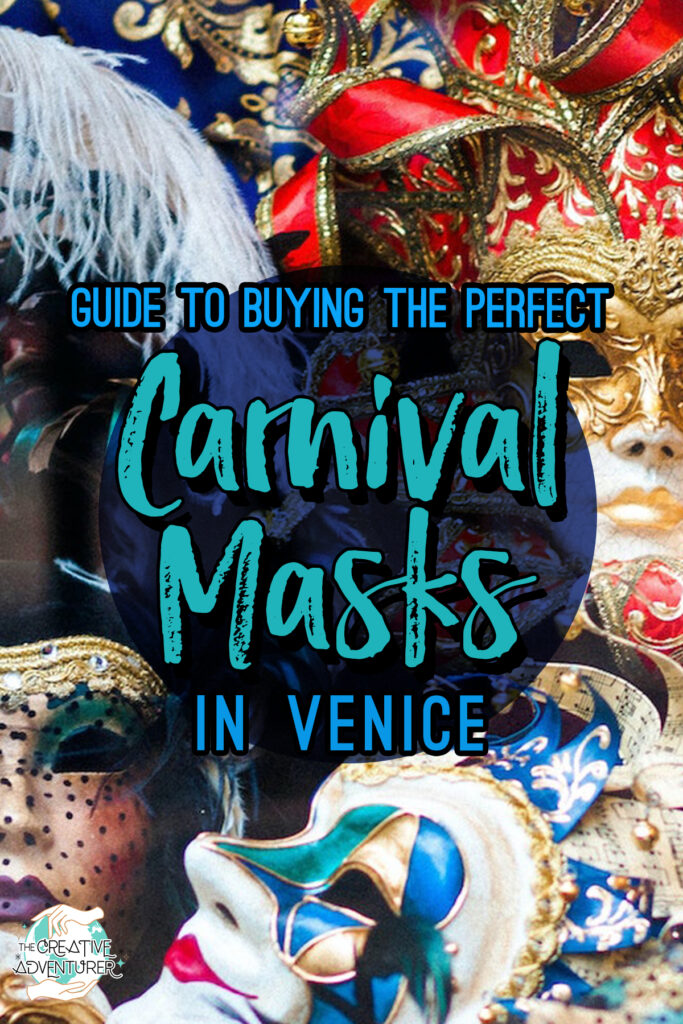
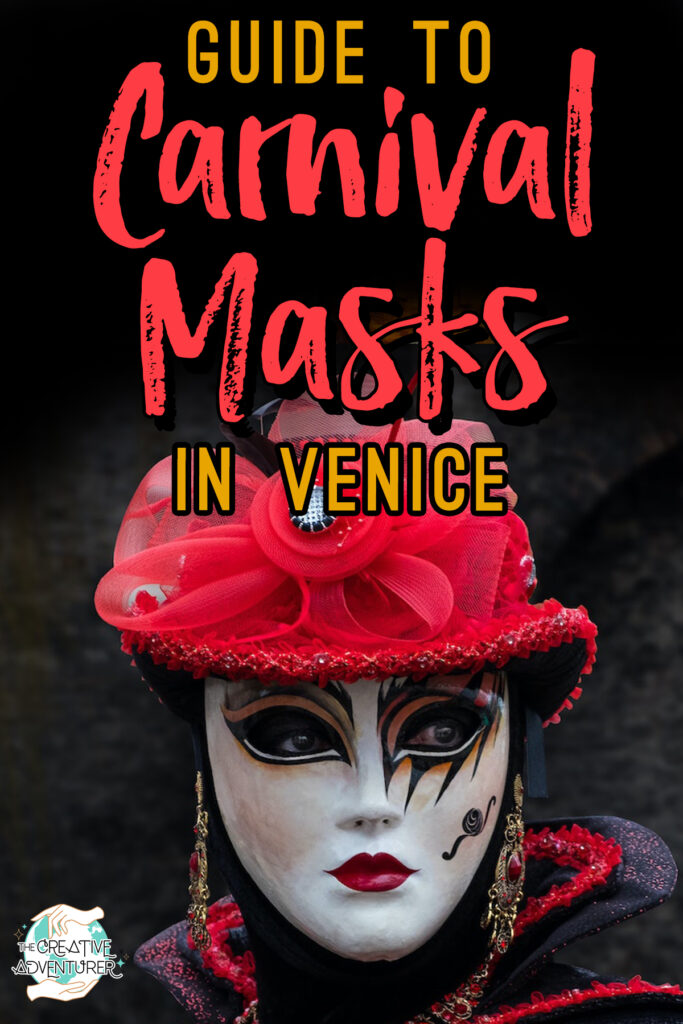

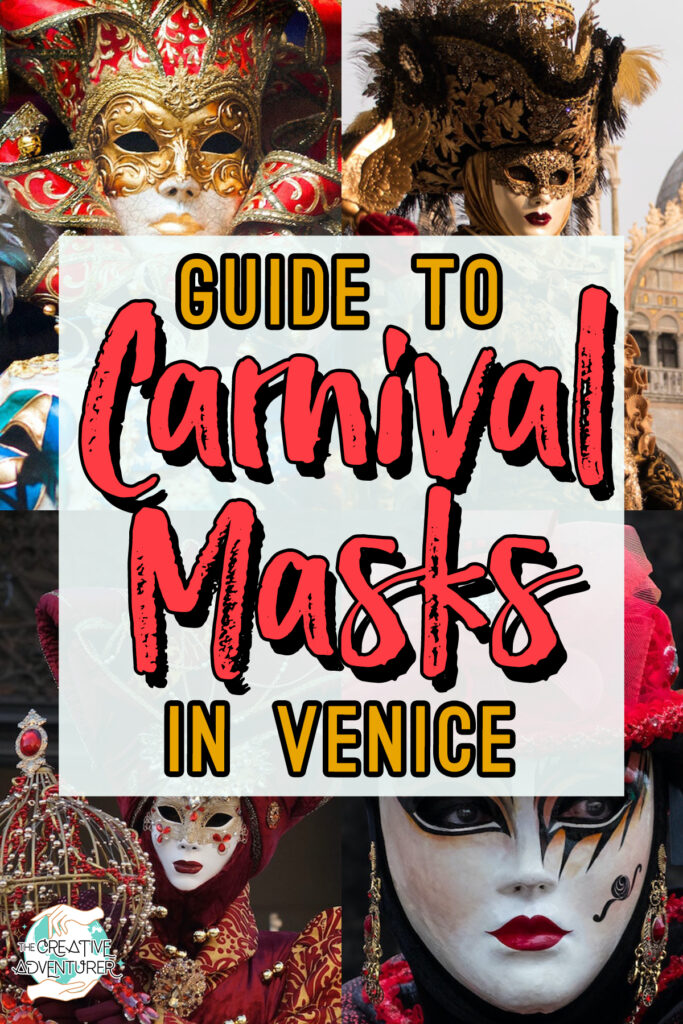



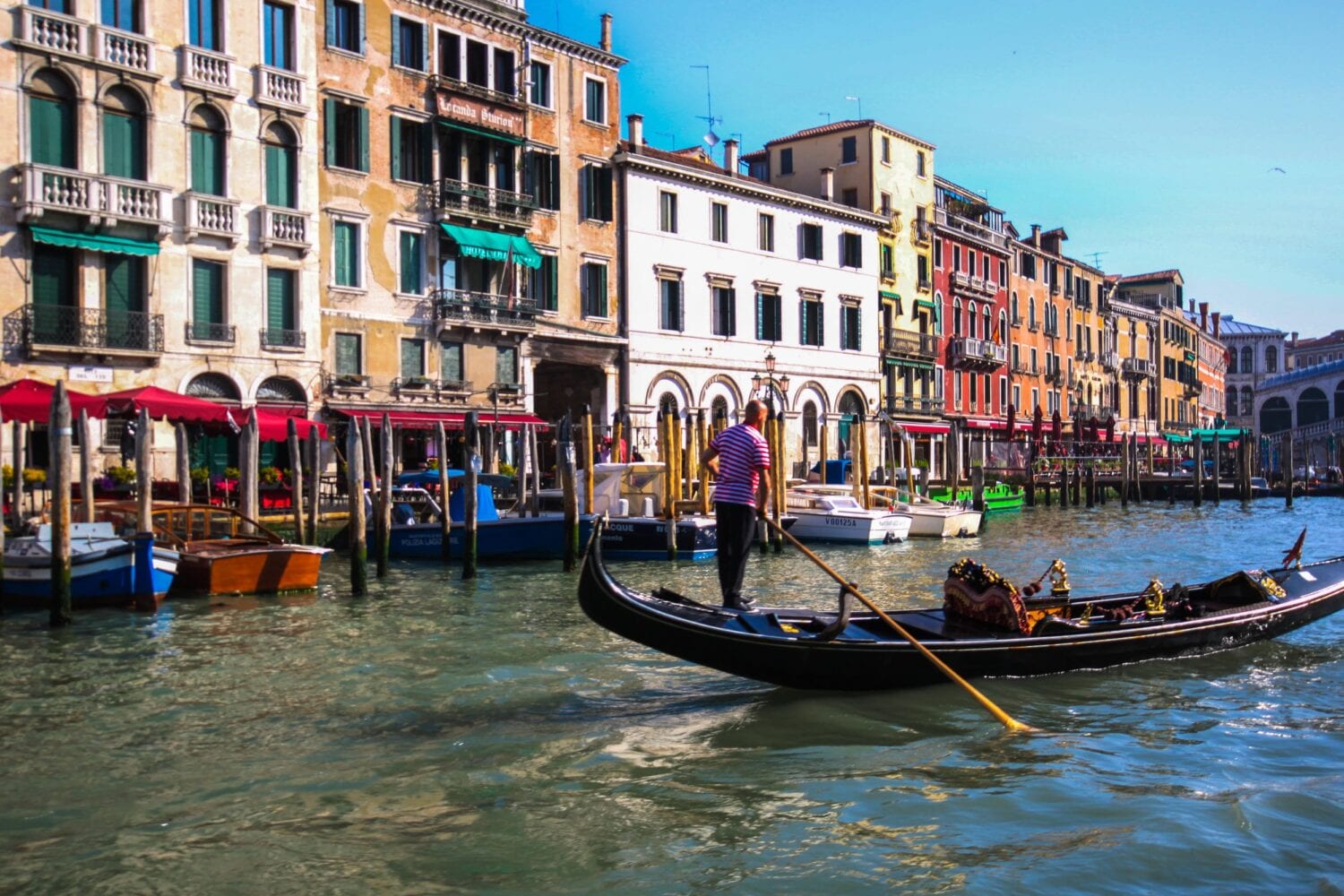
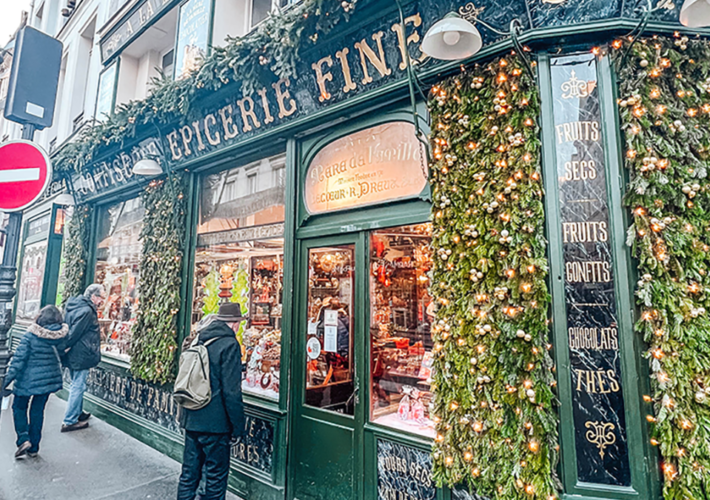

6 COMMENTS
sbobetonlinesports.blogspot.com
5 years agoWhat’s up mates, its great article concerning educationand completely defined, keep it up all the time.
wilfredbenitez
5 years agoI just like the valuable info you provide to your articles.
I’ll bookmark your blog and take a look at again right here
frequently. I’m relatively certain I will be told a lot of new stuff proper here!
Good luck for the next!
sbobetonlinebetting.weebly.com
5 years agoHighly descriptive post, I enjoyed that a lot.
Will there be a part 2?
laura.f.whelan
5 years ago AUTHORLet me know what you’d like to hear in part two!
judionlinesepakbola
5 years agoHi I am so excited I found your web site, I really found you by
mistake, while I was looking on Google for something else, Anyhow I am here now and would just like
to say kudos for a fantastic post and a all round enjoyable blog (I also love the
theme/design), I don’t have time to read it all at
the moment but I have saved it and also included your RSS
feeds, so when I have time I will be back to read a great deal more,
Please do keep up the fantastic job.
laura.f.whelan
5 years ago AUTHORThanks so much Stephania!